26th August, 2025
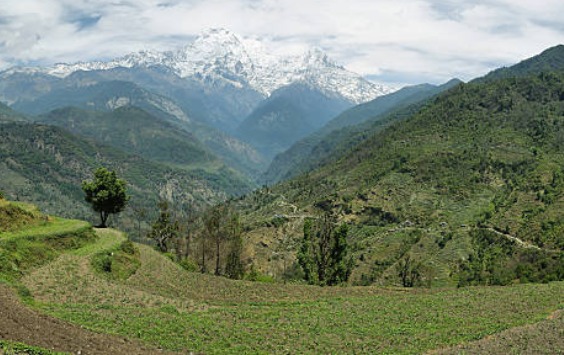
Oct 02, 2023
Annapurna Base Camp Trek in May
- Weather Conditions in May
- Trekking Routes and Itinerary
- Accommodation Along the Trek
- Food and Dining Options
- Packing List for May Trek
- Difficulty Level of the Trek
- Health and Safety Considerations
- Permits and Documentation
- Solo vs. Guided Trekking
- Cultural Experiences and Local Interaction
- Tips for Trekking in May
- Challenges and How to Overcome Them
- Photography and Scenic Spots
- Emergency and Rescue Information
- Sustainable Trekking Practices
- Travel and Transportation Tips
- Conclusion
- Annapurna Base Camp Trekking packages
The Annapurna Base Camp (ABC) trek in May offers a unique and rewarding trekking experience, combining favorable weather with vibrant natural beauty. May is the transition period from spring to summer, and it presents an excellent opportunity for trekkers to explore the Annapurna region.
During May, the weather in the Annapurna region is generally warm and pleasant. Daytime temperatures range from 10°C to 20°C (50°F to 68°F), which makes for comfortable trekking conditions. However, as you ascend to higher altitudes, temperatures can drop significantly, especially at night, so it's important to pack warm clothing. While May is generally dry, the onset of the monsoon season can lead to occasional rain, particularly in the latter part of the month. This can sometimes lead to muddy trails, but it also enhances the lush greenery of the region.

ANNAPURNA BASE CAMP TREK
The Annapurna Base Camp (ABC) Trek via Ghorepani Poon Hill Trek offers a truly unforgettable Himalayan adventure, combining stunning panoramic views with the rich cultural tapestry of the region. This...
One of the highlights of trekking in May is witnessing the tail end of the rhododendron bloom, which adds vibrant colors to the landscape. The trails are relatively less crowded compared to peak season months, allowing for a more serene trekking experience. However, as May progresses, the number of trekkers may start to increase, so it’s advisable to book accommodations in advance or arrive early at each teahouse.
In summary, trekking to Annapurna Base Camp in May offers a blend of favorable weather, beautiful spring scenery, and a generally peaceful experience, making it a fantastic time for adventurers seeking to explore the Himalayas.
Weather Conditions in May
In May, the weather conditions for the Annapurna Base Camp (ABC) trek are generally favorable but can be variable as the region transitions from spring to the monsoon season. Daytime temperatures typically range from 10°C to 20°C (50°F to 68°F), providing comfortable trekking conditions. However, temperatures at higher altitudes can drop significantly, especially at night, with lows reaching around -5°C to 0°C (23°F to 32°F). Early May is relatively dry, but as the month progresses, the likelihood of rain increases, leading to occasional showers and potentially muddy trails. While the weather is generally pleasant for trekking, be prepared for sudden changes, including cooler temperatures and possible rain, especially at higher elevations. Layered clothing and waterproof gear are essential to handle the fluctuating conditions.
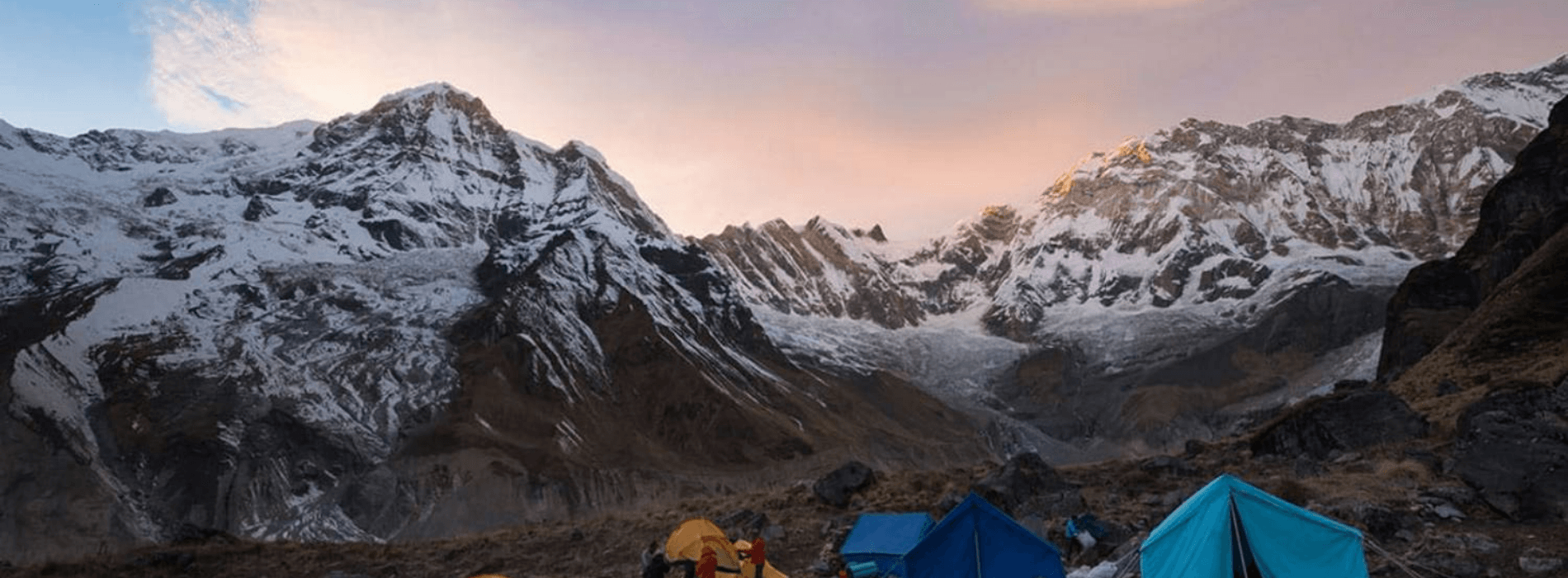
ANNAPURNA BASE CAMP TREK 6 DAYS
The 6 days Annapurna Base Camp Trek is an ideal adventure for those people who have a tight schedule but still want to experience the amazing landscape and the fascinating lifestyles of the Gurung cul...
Trekking Routes and Itinerary
The Annapurna Base Camp (ABC) trek typically follows a 10-day itinerary, with variations depending on your pace and preferences. A common itinerary includes:
Day 1: Drive or fly from Kathmandu to Pokhara.
Day 2: Drive or trek to Nayapul and start the trek to Tikhedhunga or Ulleri.
Day 3: Trek from Tikhedhunga/Ulleri to Ghorepani.
Day 4: Early morning hike to Poon Hill for sunrise, then trek to Tadapani.
Day 5: Trek from Tadapani to Chhomrong.
Day 6: Trek from Chhomrong to Dovan.
Day 7: Trek from Dovan to Machapuchare Base Camp.
Day 8: Trek from Machapuchare Base Camp to Annapurna Base Camp.
Day 9: Descend from Annapurna Base Camp to Bamboo.
Day 10: Trek from Bamboo to Nayapul, then drive or fly back to Pokhara.
This itinerary allows for acclimatization and exploration while providing a structured plan for reaching ABC and returning safely.

ANNAPURNA BASE CAMP TREK 9 DAYS
The Annapurna Base Camp (ABC) (4130m) is also known as the "Annapurna Sanctuary Trek". This trek promises “in-your-face” unprecedented views of colossal Himalaya ranges, which include Hiunchuli, Macha...
Accommodation Along the Trek
Accommodation along the Annapurna Base Camp (ABC) trek primarily consists of teahouses and lodges. In May, the teahouses are generally well-equipped to handle trekkers, though facilities can vary. In popular stops like Ghorepani and Chhomrong, you’ll find relatively comfortable lodges with basic amenities including clean bedding, communal dining areas, and warm spaces. As the trek progresses to more remote areas, the accommodations become simpler, but they still provide essential services. Booking lodges in advance or arriving early in the day is advisable, especially in busy periods. Despite basic facilities, teahouses offer a cozy environment to rest and interact with fellow trekkers. Ensure that you’re prepared for varying levels of comfort and bring any additional gear or supplies you might need.
Food and Dining Options
Food options on the Annapurna Base Camp (ABC) trek are diverse and cater to various tastes. Teahouses along the route offer a range of meals, from traditional Nepali dishes like dal bhat (rice and lentil soup) and momos (dumplings) to international fare such as pasta and pancakes. In May, when the trek sees moderate traffic, teahouses generally maintain a good standard of food. While the menu might be more limited in remote areas, staples like rice, noodles, and soups are readily available. It’s advisable to eat freshly prepared food to minimize the risk of gastrointestinal issues and drink plenty of boiled or bottled water. Carrying high-energy snacks like nuts and chocolates can be helpful for quick energy boosts during the trek.
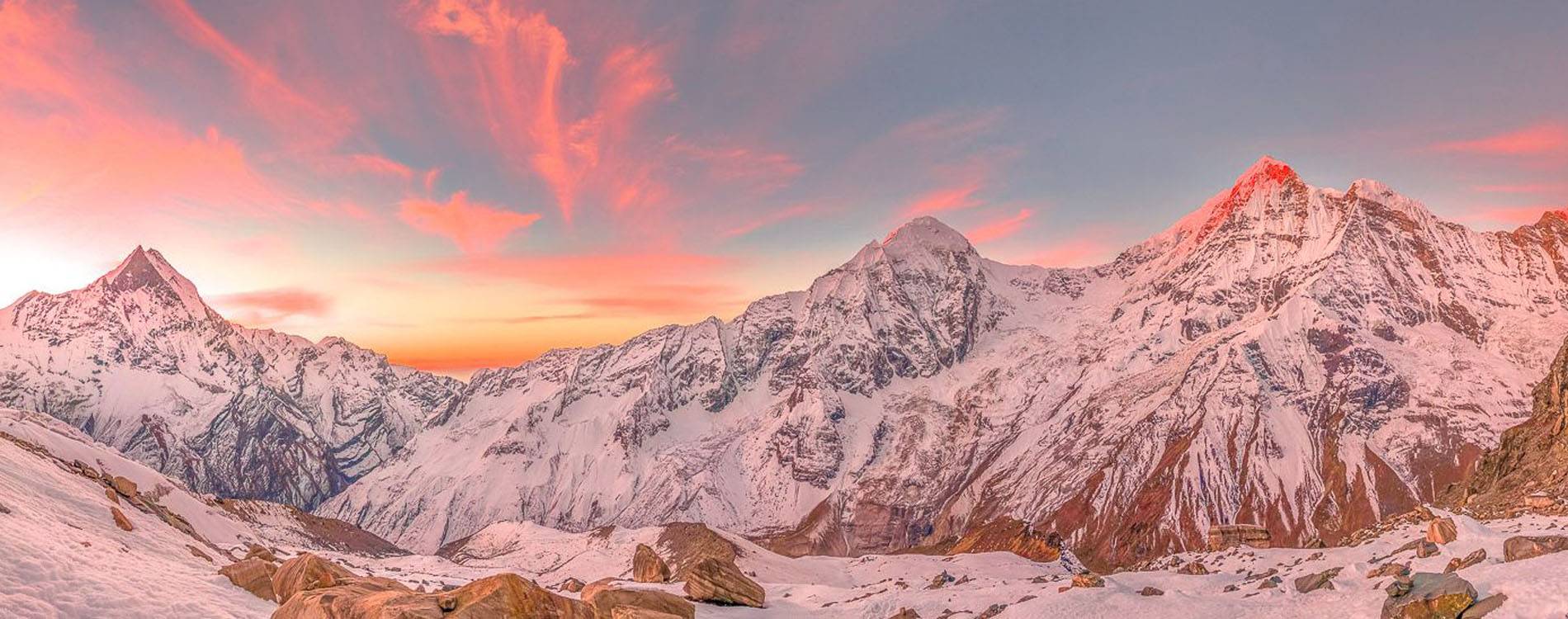
7 DAYS ANNAPURNA BASE CAMP TREK
Short on time – big on beauty!The 7 days Annapurna Base Camp Trek takes you to all the major attractions – but in less time than other treks to the Annapurna region. Take in the spectacular soaring sn...
Packing List for May Trek
For the Annapurna Base Camp (ABC) trek in May, a well-thought-out packing list is crucial. Essential items include:
- Clothing: Lightweight, moisture-wicking base layers, insulating mid-layers, and a waterproof and windproof outer layer. Pack warm clothing for colder nights.
- Footwear: Sturdy trekking boots with good ankle support and comfortable, moisture-wicking socks.
- Gear: Trekking poles, a well-fitted backpack (30-40 liters), and a sleeping bag rated for at least -10°C (14°F).
- Accessories: Sunglasses with UV protection, sunscreen, lip balm with SPF, and a headlamp with extra batteries.
- Personal Items: Reusable water bottle, water purification tablets or filter, and a basic first aid kit.
- Documents: Annapurna Conservation Area Permit (ACAP) and TIMS card.
Be prepared for a range of weather conditions and ensure you pack efficiently to carry only what is necessary for comfort and safety.
Difficulty Level of the Trek
The Annapurna Base Camp (ABC) trek in May is moderately challenging. The trek involves various terrains, including steep ascents and high-altitude paths. The trek reaches elevations of up to 4,130 meters (13,550 feet) at the base camp, requiring good acclimatization to prevent altitude sickness. While May offers relatively pleasant weather and moderate temperatures, the trek can be demanding due to the physical exertion required and the altitude. Proper preparation, including physical fitness and acclimatization, is crucial. The trek is suitable for those with reasonable trekking experience and a good level of fitness. Ensure to follow a gradual ascent, stay hydrated, and listen to your body to manage the trek’s challenges effectively.
Health and Safety Considerations
When trekking to Annapurna Base Camp (ABC) in May, health and safety are paramount. The key considerations include:
- Altitude Sickness: Acclimatize properly by ascending gradually and including rest days. Symptoms include headaches, dizziness, and nausea. If severe symptoms occur, descend immediately.
- Hydration: Drink plenty of water to stay hydrated. Avoid drinking untreated water and use purification tablets or filters.
- Weather Preparedness: Prepare for cold nights and potential rain by packing appropriate clothing and gear.
- First Aid: Carry a basic first aid kit including altitude sickness medication, bandages, and antiseptic.
- Health Monitoring: Regularly monitor your health and be aware of any signs of illness or fatigue. Seek medical attention if needed.
Following these guidelines will help ensure a safe and enjoyable trekking experience in the Annapurna region.
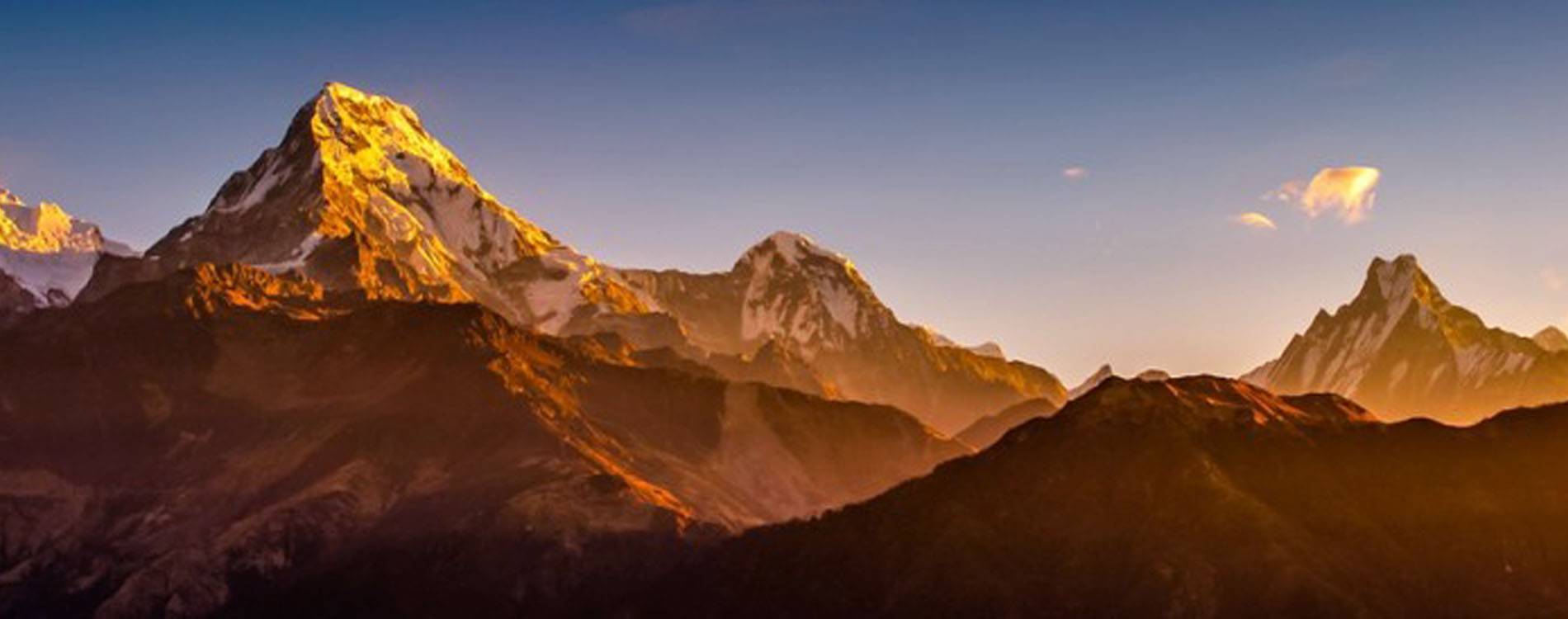
12 DAYS ANNAPURNA BASE CAMP TREK
DOUBLE THE ADVENTURE IN JUST 12 DAYS! The 12 Day Annapurna Base Camp Trek combines two well-known and popular treks into one - the Ghorepani Poon Hill Trek and the Annapurna Base Camp Trek (ABC)....
Permits and Documentation
To trek to Annapurna Base Camp (ABC), you need two essential permits: the Annapurna Conservation Area Permit (ACAP) and the Trekkers' Information Management System (TIMS) card. The ACAP is required for entry into the Annapurna Conservation Area and costs approximately $30 USD. The TIMS card helps manage and monitor trekking activities, costing around $10 USD for individual trekkers. Both permits are available from the Nepal Tourism Board offices in Kathmandu or Pokhara, or through registered trekking agencies. It's crucial to carry these permits at all times during your trek, as they will be checked at various checkpoints along the trail. Ensure that your permits are in order before you start your trek to avoid any issues. Keep photocopies of your permits and a valid passport with you, as these are often required at check-in points. Obtaining these permits is a straightforward process and essential for a hassle-free trekking experience in the Annapurna region.
Solo vs. Guided Trekking
When considering the Annapurna Base Camp (ABC) trek, you have the option to trek solo or with a guide. Solo trekking offers independence and flexibility, allowing you to set your own pace and schedule. However, it requires significant self-reliance and experience, including navigation skills and acclimatization knowledge. Solo trekkers should be well-prepared with detailed maps, emergency contacts, and a good understanding of high-altitude trekking.
On the other hand, hiring a guide provides several benefits. Guides offer local knowledge, assist with navigation, and ensure safety, especially in challenging conditions. They can help manage logistics, such as arranging accommodations and meals, and provide valuable insights into local culture. For those unfamiliar with high-altitude trekking or the Annapurna region, a guide can enhance safety and enrich the overall experience. Ultimately, the choice depends on your experience level and personal preference for independence versus guided support.
Cultural Experiences and Local Interaction
The Annapurna Base Camp (ABC) trek offers rich cultural experiences and opportunities for local interaction. Along the trail, you'll encounter various ethnic communities such as the Gurung and Magar, each with unique traditions and customs. Teahouses and lodges are often run by local families, providing a chance to experience traditional Nepalese hospitality and cuisine. Engaging with locals can offer insights into their way of life, customs, and festivals.
In villages like Ghorepani and Chhomrong, you might witness local festivals and ceremonies, providing a deeper understanding of the cultural fabric of the region. Respecting local customs and traditions is essential, such as asking for permission before taking photos and dressing modestly. By interacting respectfully with local residents, you enhance your trekking experience and contribute to responsible tourism in the region.
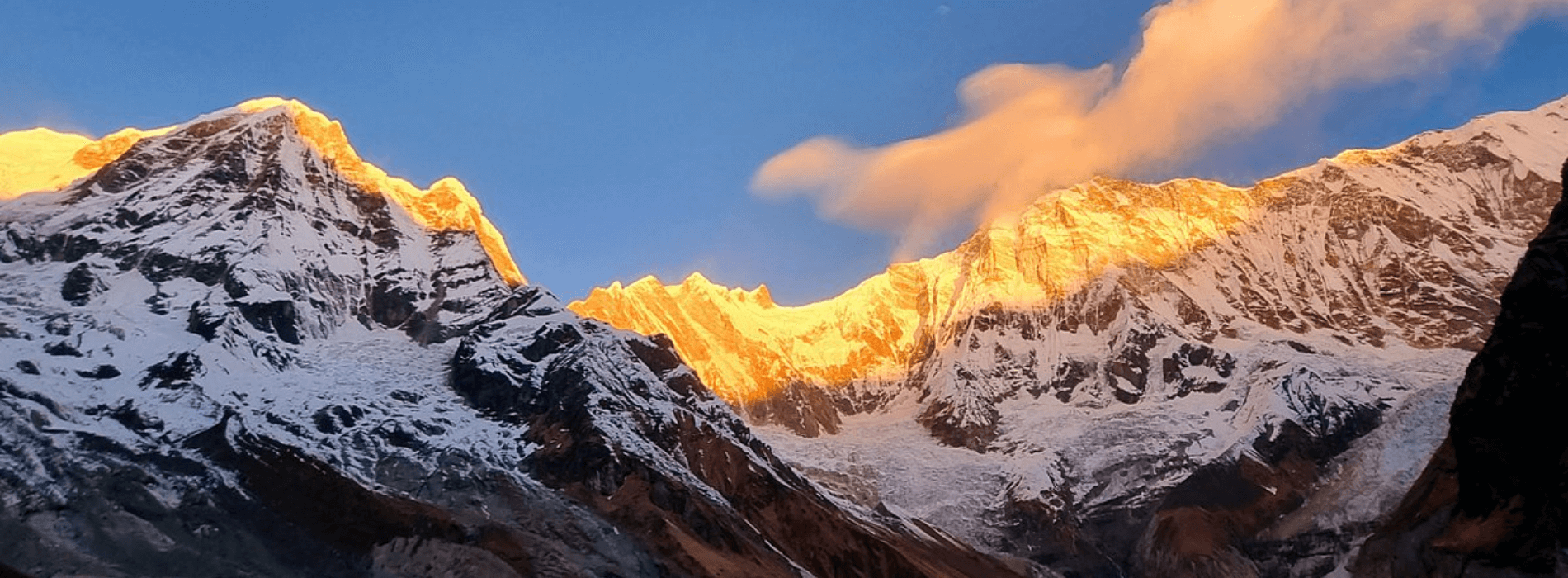
ANNAPURNA BASE CAMP TREK 10 DAYS
This 10 days Annapurna Base Camp (ABC) trek brings you into the heart of Nepal's Himalayas from the very being of the hike. With so many snow-capped peaks on the show, it is no surprise this one-week-...
Tips for Trekking in May
Trekking to Annapurna Base Camp (ABC) in May requires some specific preparations due to the transitional weather. Here are key tips to ensure a successful trek:
- Weather Readiness: Prepare for variable weather, including potential rain and cooler temperatures at higher altitudes. Pack waterproof and layered clothing.
- Acclimatization: Follow a gradual ascent schedule to avoid altitude sickness. Include rest days and monitor your health closely.
- Hydration and Nutrition: Drink plenty of water and consume high-energy snacks to maintain energy levels.
- Permits: Ensure you have all necessary permits, such as the ACAP and TIMS card, and carry them with you at all times.
- Accommodation: Book lodges in advance or arrive early to secure accommodation, especially as the number of trekkers may increase towards the end of May.
- Flexibility: Be prepared for trail conditions to vary, and have contingency plans for weather-related disruptions.
By following these tips, you can maximize your enjoyment and ensure a smoother trekking experience in May.
Challenges and How to Overcome Them
The Annapurna Base Camp (ABC) trek in May presents several challenges, but with proper preparation, they can be managed effectively:
- Variable Weather: May sees the beginning of the monsoon season, leading to possible rain and muddy trails. To overcome this, pack waterproof gear, sturdy footwear, and be prepared for changing conditions.
- Altitude Sickness: At higher altitudes, acclimatization is crucial. Ascend gradually, take rest days, and stay hydrated. Recognize symptoms early and descend if necessary.
- Crowds: As May progresses, the number of trekkers may increase. Book accommodations in advance and start your trek early in the day to avoid congestion.
- Trail Conditions: Rain can make trails slippery and challenging. Use trekking poles for stability and be cautious on steep sections.
- Limited Supplies: Remote areas may have limited resources. Carry essential supplies, including snacks, medications, and a first aid kit.
By addressing these challenges proactively, you can enjoy a safe and memorable trek to Annapurna Base Camp.

KHOPRA DANDA TREK 9 DAYS
9 Days Short Khopra Danda Trek is One of the rarer trails of the Annapurna region with equally magnificent views of the high Himalayas peaks. The Khopra Ridge Khayer lake trek is one of the lesser-cro...
Photography and Scenic Spots
May is an excellent time to embark on the Annapurna Base Camp (ABC) trek, offering a vibrant spectacle of nature. The spring season brings blooming rhododendrons and other wildflowers, painting the landscape with vivid colors. Clear skies and moderate temperatures make for ideal photography conditions, with the majestic Annapurna and Machapuchare (Fishtail) peaks standing out prominently against the backdrop. Key scenic spots include Poon Hill, where you can capture stunning sunrise panoramas, and the Annapurna Sanctuary, a natural amphitheater surrounded by snow-capped giants. The lush green terraces and terraced fields along the trek also provide picturesque scenes. To make the most of your photography, use a wide-angle lens for landscapes and a telephoto lens for distant peaks. Early morning and late afternoon light offers the best conditions for capturing dramatic landscapes and vibrant colors.
Emergency and Rescue Information
Trekking in the Annapurna region requires preparedness for emergencies. If you face altitude sickness or other health issues, the first step is to descend to a lower altitude and seek medical attention. Carry a comprehensive first-aid kit and know the location of the nearest medical facilities. The Annapurna region has rescue services, including helicopters for airlifts in severe cases. Ensure you have adequate travel insurance that covers high-altitude trekking and emergency evacuations. The local trekking agencies can assist in organizing rescue operations if needed. Always inform someone of your itinerary and expected return, and maintain regular communication with your team.
Sustainable Trekking Practices
Sustainable trekking is vital for preserving the natural beauty of the Annapurna region. Follow the Leave No Trace principles: pack out all waste, use designated toilets, and avoid disrupting wildlife. Support local communities by buying goods and services from local vendors rather than bringing in imported products. Respect cultural norms and traditions, and be mindful of your environmental impact. Opt for eco-friendly trekking gear and practices, such as using water purification tablets or filters instead of disposable plastic bottles. By making conscious choices, trekkers can contribute to the preservation of this pristine environment for future generations.
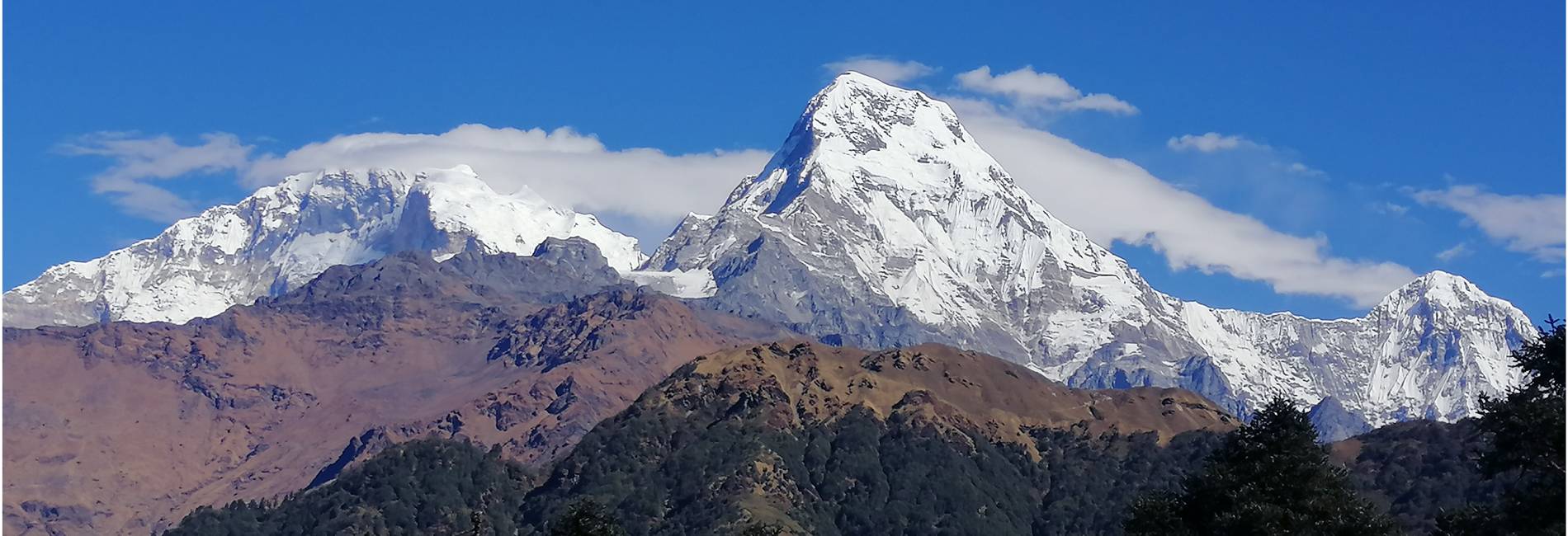
SHORT ANNAPURNA TREK
The Ghorepani Poon Hill Trek, also known as the Annapurna trek or Annapurna C trek, is a captivating journey through the Annapurna region of Nepal, renowned for its natural beauty and cultural richnes...
Travel and Transportation Tips
Traveling to Annapurna Base Camp involves reaching Pokhara first. From Kathmandu, you can take a domestic flight or a long-distance bus to Pokhara. The flight is quicker but more expensive, while the bus journey offers scenic views and is budget-friendly. In Pokhara, you’ll need to arrange transportation to Nayapul, the starting point of the trek. Consider hiring a private vehicle for convenience or using local buses. While trekking, be prepared for basic accommodations and limited amenities. Ensure you have all necessary permits, including the Annapurna Conservation Area Permit (ACAP) and the TIMS (Trekkers' Information Management System) card. Plan your trek schedule according to your fitness level and acclimatization needs.
Conclusion
The Annapurna Base Camp trek in May provides a remarkable experience with its stunning landscapes, favorable weather, and rich flora. Proper preparation and knowledge about emergency protocols, sustainable practices, and travel logistics are essential for a successful trek. Embrace the natural beauty, respect the local environment and culture, and ensure you are well-prepared for unforeseen situations. This trek not only offers breathtaking views and adventure but also an opportunity to contribute positively to the preservation of one of Nepal’s most iconic trekking routes. Enjoy your journey and the extraordinary beauty of the Annapurna region.
Annapurna Base Camp Trekking packages
14 Days Annapurna Base Camp Trek
13 Days Annapurna Base Camp Trek
12 Days Annapurna Base Camp Trek
9 Days Annapurna Base Camp Trek
7 Days Annapurna Base Camp Trek
6 Days Annapurna Base Camp Trek
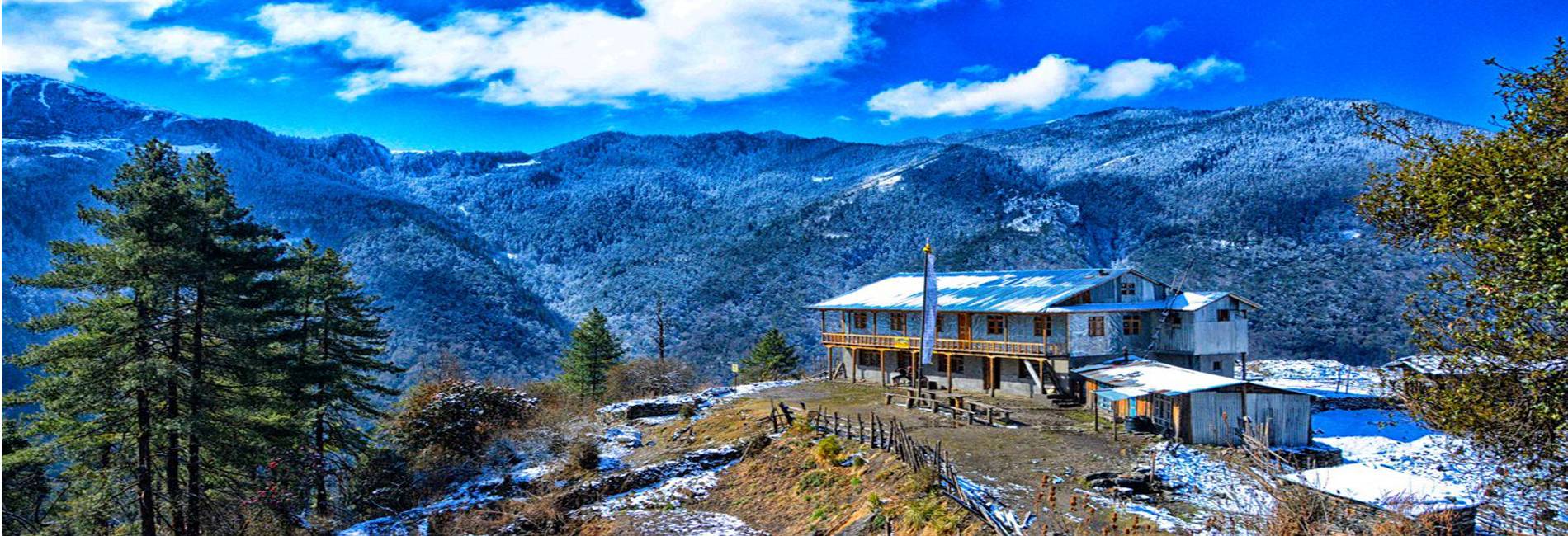
MOHARE DANDA TREK
DON’T LIKE CROWDS – TRY THIS NEW ECO-TOURISM TREK.The Mohare Danda (3313m) Trek is a new destination where trekkers stay in community-owned lodges or homestay. This gives you a more intimate experienc...
Any Questions? Let Us Know.
Recent Posts
17th June, 2025


















